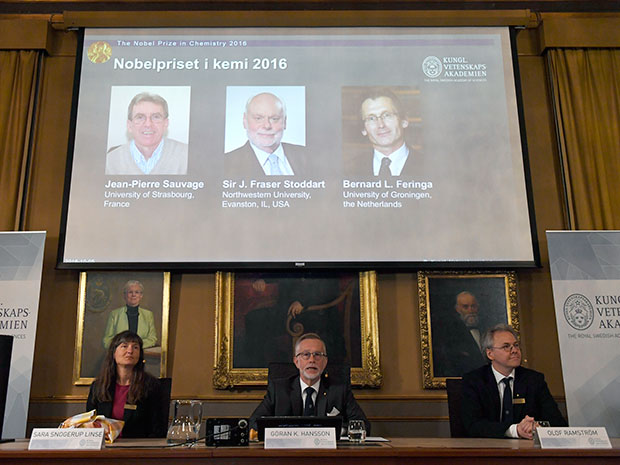For some, it might seem like a shock while for some it would be a confirmation to those who envision molecular nanotechnology as the real future of nanotechnology, Jean Pierre Sauvage, Bernard Feringa, and Sir J. Fraser Stodard have been greeted with the 2016 Nobel Prize in Chemistry for their enhancement of molecular machines.

The Nobel Prize was offered to all three of the researchers based on their complementary work over three decades. Firstly, in 1983, Sauvage was able to combine two ring – shaped molecules to create a chain. Then after eight years, Stoddart, a lecturer at Northwestern University in Evanston, illustrated that a molecular ring could transform a sleek molecular axle. The after more eight years, Feringa, a lecturer at the University of Groningen, in Netherlands, structured on Stoddart’s work and prepared a molecular rotor blade that can rotate regularly in the same direction.
The molecular nanotechnology world is most familiar with the work of Feringa. He is the one offered with being the first person to enhance a real molecular motor. It is true that such molecular machines are very much far from possessing any real-world, practical applications. Despite nods in the report to nanoparticles moving through the bloodstream to offer drugs, the nanogears, nanomachines and nanocars introduced by the present year’s Nobel Laureated in Chemistry settled a long way from bringing the reality the basic hope of molecular nanotechnology (MNT) that such machines will function in unison to construct macroscale gadgets. But, this Nobel Price is as much of importance to future research as it is an identification of what all has been already accomplished.
Considering the selection of the Nobel committee, Donna Nelson, a chemist and also the president of the American Chemical Society informed that, “I think this subject is going to be fantastic for science. When the Nobel Prize is awarded, it becomes an inspiration to other researchers as well. It also boosts funding process.” Nelson further stated that this theme of research would be interesting for children. “They can witness it and think of a nanocar. It comes at a great time when we are required to inspire the upcoming generation of researchers.”
Indeed, the nanomachines to gather our thinking ideology and have witnessed a great role in an augmenting number of sci-fi novels and movies. But, an experimental study in adapting these nano machines and nano gears into the sort of MNT manufacturing that is forecasted in such works and practises of fiction expects to be still lacking.
The supporters of MNT have witnessed an insufficient volume of funds and even a great lack of funding. It is not just a lack but a huge obstacle in conducting further research works related to the field. Due to immense lack, even it is expected that more new studies and researches will not be able to overcome within the desired time frame. Whether this present Nobel Prize will spur some funding elements to open up the door to realize the extensive ability that such initial work might seem promising is still a big question that only time would be able to answer.
Filed Under: News


Questions related to this article?
👉Ask and discuss on EDAboard.com and Electro-Tech-Online.com forums.
Tell Us What You Think!!
You must be logged in to post a comment.